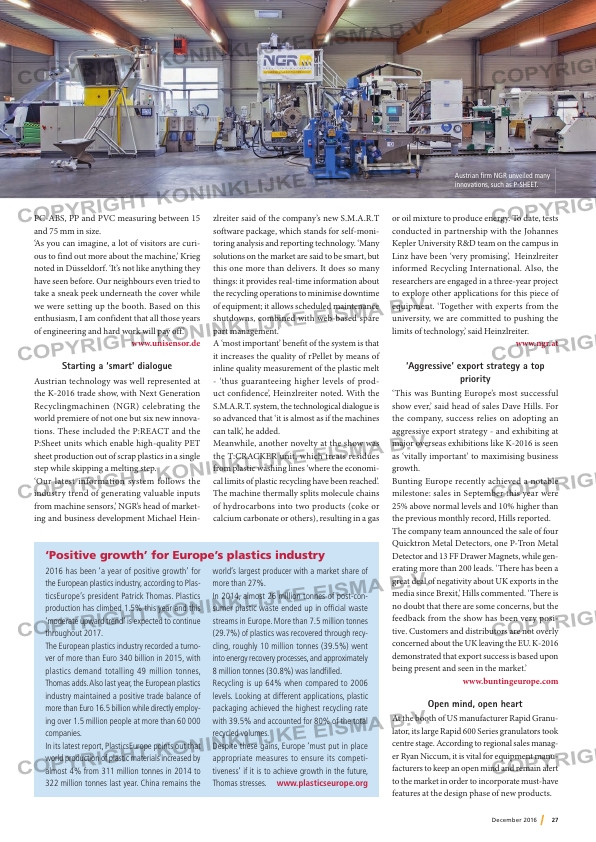Page 27 from: December 2016

27December 2016
PC-ABS, PP and PVC measuring between 15
and 75 mm in size.
‘As you can imagine, a lot of visitors are curi-
ous to find out more about the machine,’ Krieg
noted in Düsseldorf. ‘It’s not like anything they
have seen before. Our neighbours even tried to
take a sneak peek underneath the cover while
we were setting up the booth. Based on this
enthusiasm, I am confident that all those years
of engineering and hard work will pay off.’
www.unisensor.de
Starting a ‘smart’ dialogue
Austrian technology was well represented at
the K-2016 trade show, with Next Generation
Recyclingmachinen (NGR) celebrating the
world premiere of not one but six new innova-
tions. These included the P:REACT and the
P:Sheet units which enable high-quality PET
sheet production out of scrap plastics in a single
step while skipping a melting step.
‘Our latest information system follows the
industry trend of generating valuable inputs
from machine sensors,’ NGR’s head of market-
ing and business development Michael Hein-
zlreiter said of the company’s new S.M.A.R.T
software package, which stands for self-moni-
toring analysis and reporting technology. ‘Many
solutions on the market are said to be smart, but
this one more than delivers. It does so many
things: it provides real-time information about
the recycling operations to minimise downtime
of equipment; it allows scheduled maintenance
shutdowns, combined with web-based spare
part management.’
A ‘most important’ benefit of the system is that
it increases the quality of rPellet by means of
inline quality measurement of the plastic melt
– ‘thus guaranteeing higher levels of prod-
uct confidence’, Heinzlreiter noted. With the
S.M.A.R.T. system, the technological dialogue is
so advanced that ‘it is almost as if the machines
can talk’, he added.
Meanwhile, another novelty at the show was
the T:CRACKER unit, which treats residues
from plastic washing lines ‘where the economi-
cal limits of plastic recycling have been reached’.
The machine thermally splits molecule chains
of hydrocarbons into two products (coke or
calcium carbonate or others), resulting in a gas
or oil mixture to produce energy. To date, tests
conducted in partnership with the Johannes
Kepler University R&D team on the campus in
Linz have been ‘very promising’, Heinzlreiter
informed Recycling International. Also, the
researchers are engaged in a three-year project
to explore other applications for this piece of
equipment. ‘Together with experts from the
university, we are committed to pushing the
limits of technology,’ said Heinzlreiter.
www.ngr.at
‘Aggressive’ export strategy a top
priority
‘This was Bunting Europe’s most successful
show ever,’ said head of sales Dave Hills. For
the company, success relies on adopting an
aggressive export strategy – and exhibiting at
major overseas exhibitions like K-2016 is seen
as ‘vitally important’ to maximising business
growth.
Bunting Europe recently achieved a notable
milestone: sales in September this year were
25% above normal levels and 10% higher than
the previous monthly record, Hills reported.
The company team announced the sale of four
Quicktron Metal Detectors, one P-Tron Metal
Detector and 13 FF Drawer Magnets, while gen-
erating more than 200 leads. ‘There has been a
great deal of negativity about UK exports in the
media since Brexit,’ Hills commented. ‘There is
no doubt that there are some concerns, but the
feedback from the show has been very posi-
tive. Customers and distributors are not overly
concerned about the UK leaving the EU. K-2016
demonstrated that export success is based upon
being present and seen in the market.’
www.buntingeurope.com
Open mind, open heart
At the booth of US manufacturer Rapid Granu-
lator, its large Rapid 600 Series granulators took
centre stage. According to regional sales manag-
er Ryan Niccum, it is vital for equipment manu-
facturers to keep an open mind and remain alert
to the market in order to incorporate must-have
features at the design phase of new products.
‘Positive growth’ for Europe’s plastics industry
2016 has been ‘a year of positive growth’ for
the European plastics industry, according to Plas-
ticsEurope’s president Patrick Thomas. Plastics
production has climbed 1.5% this year and this
‘moderate upward trend’ is expected to continue
throughout 2017.
The European plastics industry recorded a turno-
ver of more than Euro 340 billion in 2015, with
plastics demand totalling 49 million tonnes,
Thomas adds. Also last year, the European plastics
industry maintained a positive trade balance of
more than Euro 16.5 billion while directly employ-
ing over 1.5 million people at more than 60 000
companies.
In its latest report, PlasticsEurope points out that
world production of plastic materials increased by
almost 4% from 311 million tonnes in 2014 to
322 million tonnes last year. China remains the
world’s largest producer with a market share of
more than 27%.
In 2014, almost 26 million tonnes of post-con-
sumer plastic waste ended up in official waste
streams in Europe. More than 7.5 million tonnes
(29.7%) of plastics was recovered through recy-
cling, roughly 10 million tonnes (39.5%) went
into energy recovery processes, and approximately
8 million tonnes (30.8%) was landfilled.
Recycling is up 64% when compared to 2006
levels. Looking at different applications, plastic
packaging achieved the highest recycling rate
with 39.5% and accounted for 80% of the total
recycled volumes.
Despite these gains, Europe ‘must put in place
appropriate measures to ensure its competi-
tiveness’ if it is to achieve growth in the future,
Thomas stresses. www.plasticseurope.org
Austrian firm NGR unveiled many
innovations, such as P-SHEET.



